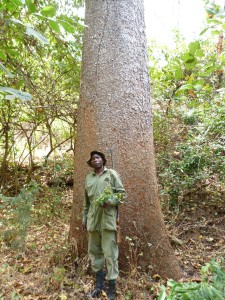Dry Season Trip to Selous Game Reserve – Day Three
Our first full day in the field dawned. An excited group of ecologists loaded up in two Toyota Landcruisers and headed along a series of wooded ridges to the northern part of the project area. Within 30 minutes of leaving camp we came across one of the trip highlights…..a pack of African Wild Dogs with pups!! What an astounding start to the trip! The dogs played in the road in front of our vehicle, quite unafraid and in fact quite curious. I must have got about 20 great shots of the dogs before they were spooked by something and headed into the woodland. Does it get better than this??  As we headed north the vegetation changed from tall miombo woodland, i.e. woodland dominated by trees in the genera Brachystegia and Julbernardia, to tall, dense thickets dominated by Pteleopsis myrtifolia and Terminalia sambesiaca. The two vegetation types are very different in structure and plant composition, with very little species overlap. Consequently, the bird communities in each are very different and our arrival in the northern thickets was heralded by exotic bird calls such as Eastern Green Tinkerbird, African Broadbill and Eastern Nicator. We drove down one of the ridges to a northern tributary of the Mkuju River and parked in the forest along the river banks. A remarkable 4-5 hours were spent surveying the flora, birds, invertebrates and wetlands in this area. The first vegetation quadrat confirmed that this was a very interesting thicket type with more affinities with coastal thickets and lowland forest than the miombo woodland that it was embedded in. Some of the interesting species included the climbing Combretum pentagonum, Keetia sansibarica, Craibia zimmermannii and Leptactina platyphylla. One highlight was a massive Milicia excelsa tree that emerged at least 15 metres above the thicket canopy.
As we headed north the vegetation changed from tall miombo woodland, i.e. woodland dominated by trees in the genera Brachystegia and Julbernardia, to tall, dense thickets dominated by Pteleopsis myrtifolia and Terminalia sambesiaca. The two vegetation types are very different in structure and plant composition, with very little species overlap. Consequently, the bird communities in each are very different and our arrival in the northern thickets was heralded by exotic bird calls such as Eastern Green Tinkerbird, African Broadbill and Eastern Nicator. We drove down one of the ridges to a northern tributary of the Mkuju River and parked in the forest along the river banks. A remarkable 4-5 hours were spent surveying the flora, birds, invertebrates and wetlands in this area. The first vegetation quadrat confirmed that this was a very interesting thicket type with more affinities with coastal thickets and lowland forest than the miombo woodland that it was embedded in. Some of the interesting species included the climbing Combretum pentagonum, Keetia sansibarica, Craibia zimmermannii and Leptactina platyphylla. One highlight was a massive Milicia excelsa tree that emerged at least 15 metres above the thicket canopy. 
 Evidence of regular Elephant traffic and some Buffalo spoor kept us as alert as possible, although we were accompanied by Wildlife Department guards whose senses were far more finely tuned than ours! A late lunch was eaten in the shade of the tall riparian thicket trees. An hour was then spent across the stream in similar thickets, part of which was trying to track down an elusive but very vocal Eastern Green Tinkerbird, to no avail! Our driver was then instructed to drive to a river crossing downstream where he would wait for us. We then set off along the stream bed on foot, spending some of the time crossing grassy wetlands and the rest in the thickets above the banks. A sinister buffalo skull was a reminder of what we needed to be alert for.
Evidence of regular Elephant traffic and some Buffalo spoor kept us as alert as possible, although we were accompanied by Wildlife Department guards whose senses were far more finely tuned than ours! A late lunch was eaten in the shade of the tall riparian thicket trees. An hour was then spent across the stream in similar thickets, part of which was trying to track down an elusive but very vocal Eastern Green Tinkerbird, to no avail! Our driver was then instructed to drive to a river crossing downstream where he would wait for us. We then set off along the stream bed on foot, spending some of the time crossing grassy wetlands and the rest in the thickets above the banks. A sinister buffalo skull was a reminder of what we needed to be alert for.  We arrived at the stream crossing as the sun was dipping towards the horizon and met up with the invertebrate survey team. It was the end of a very productive day and time to head back to camp to enjoy a cold drink on the viewing platform.
We arrived at the stream crossing as the sun was dipping towards the horizon and met up with the invertebrate survey team. It was the end of a very productive day and time to head back to camp to enjoy a cold drink on the viewing platform.